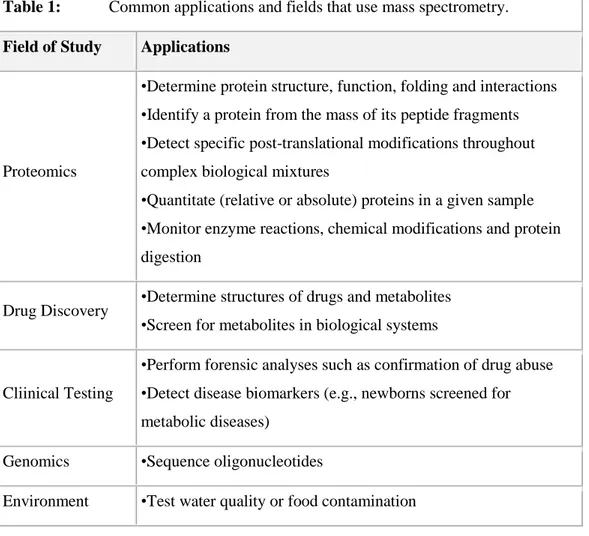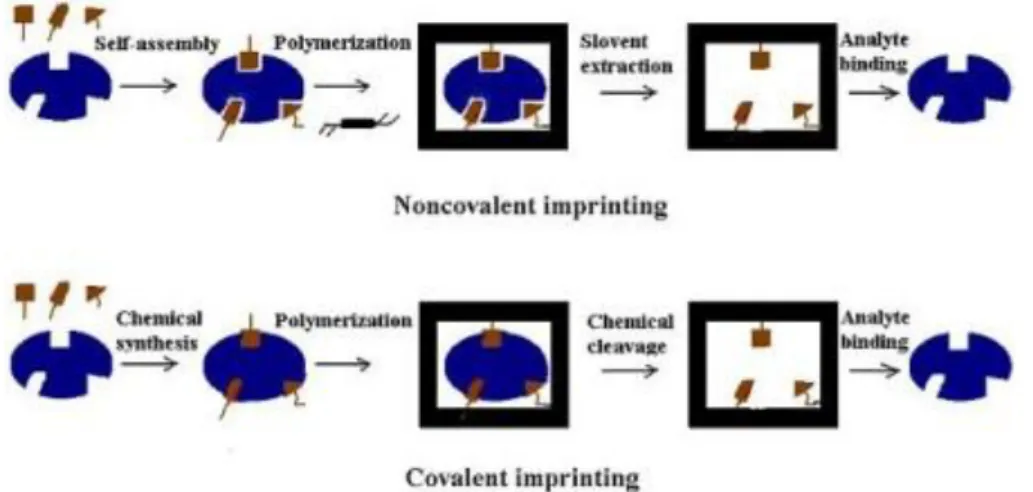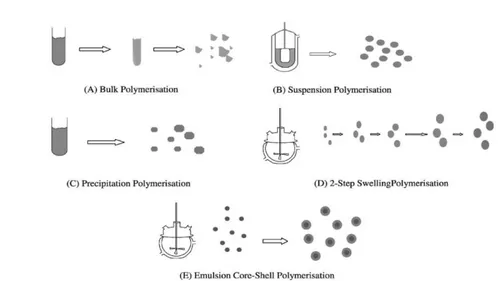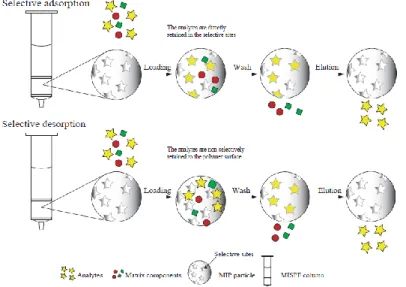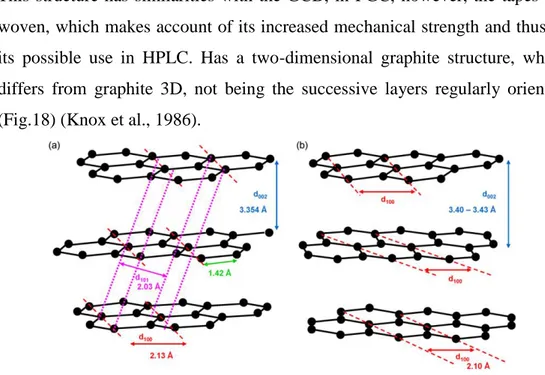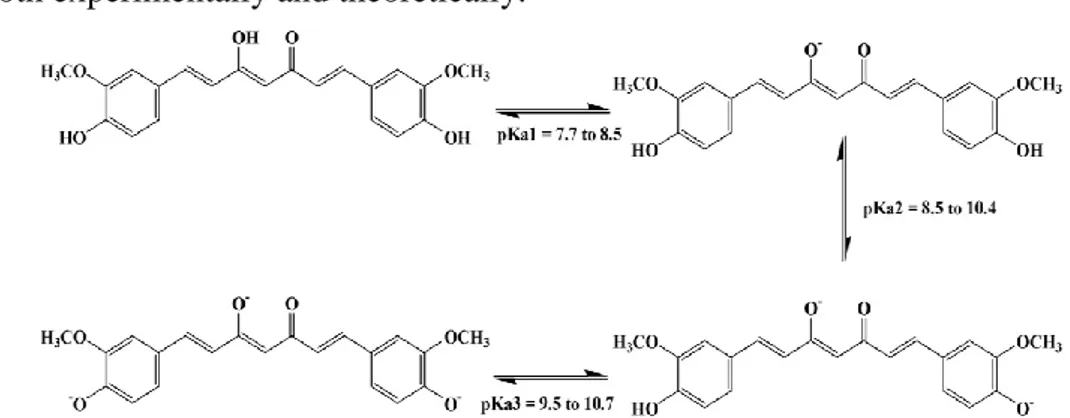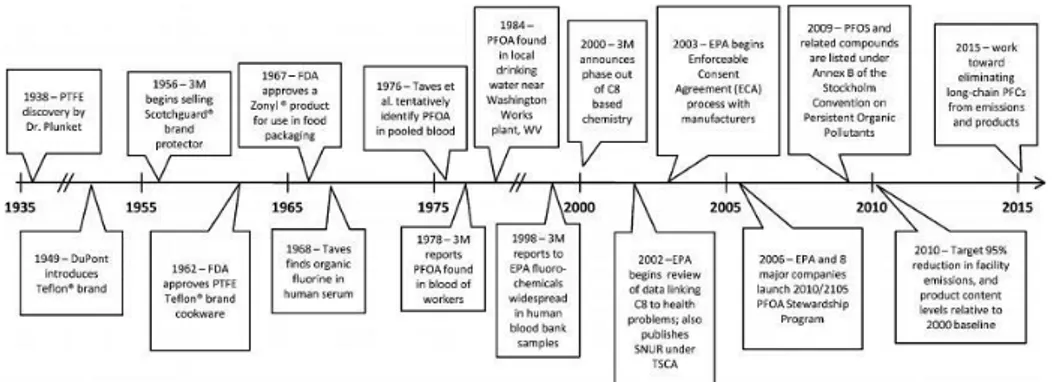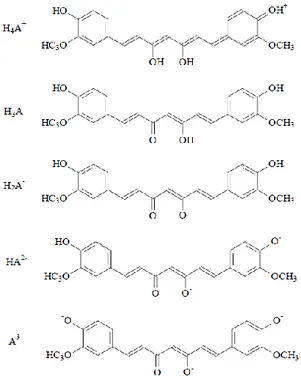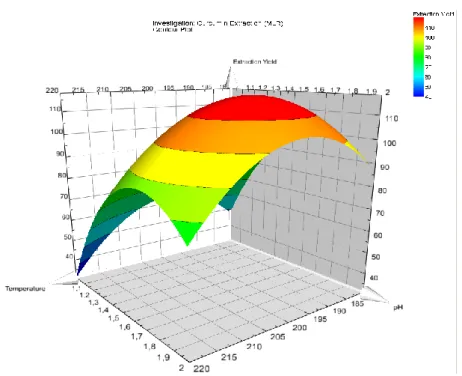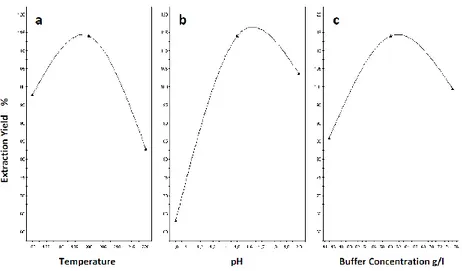Non basta guardare, occorre guardare con occhi che vogliono vedere, che credono in quello che vedono
UNIVERSITÀ DEGLI STUDI DI SALERNO DIPARTIMENTO DI FARMACIA
Dottorato di Ricerca in Scienza e Tecnologie per l’Industria Chimica, Farmaceutica e Alimentare
XI course NS (XXV) 2009-2012
“DEVELOPMENT OF SELECTIVE MATERIALS AND
METHODS FOR ANALYTICAL TECHNIQUES
COMBINED WITH MASS SPECTROMETRY”
Tutor PhD Student
Prof. Carlo Crescenzi Maria Anna Euterpio
Coordinators
Table of contents I TABLE OF CONTENTS LIST OF PUBLICATIONS ABSTRACT 1 INTRODUCTION
1.1 Mass spectrometry as detection technique for liquid chromatography
1.1.1 Frequent troubles in combining liquid chromatography and mass spectrometry 1.1.2 Tandem mass spectrometry
1.1.3 Matrix effects on the MS detection
1.2 Sample preparation techniques coupled with LC/MS
1.1.1 Subcritical-water extraction and green chemistry 1.2.1.1 History
1.2.1.2 Extraction of solid samples 1.2.1.3 Water as solvent
1.2.1.3.1 Physical and chemical characteristic of water 1.2.1.4 Sub- and supercritical water
1.2.1.5 Parameters affecting the SWE process 1.2.1.6 SWE application
1.2.2 Solid Phase Extraction (SPE)
1.2.3 Online and offline methods for sample preparation 1.2.4 Immunoaffinity extraction
1.2.5 Molecularly imprinted polymers (MIPs) 1.2.5.1 MIP‘s history VII-VIII 1-3 5-58 7 10 11 14 15 15 17 17 19 20 22 23 25 26 29 32 34 36
Table of contents
II 1.2.5.2 NIP and MIP
1.2.5.3 Variables in MIP‘s synthesis a) Template
b) Functional monomer c) Crosslinking
d) Porogen e) Initiator
1.2.5.4 Other variables in MIP‘s synthesis 1.2.5.5 Type of polymerization
1.2.5.6 MISPE
1.2.6 History of Graphitized Carbon as sorbent material 1.2.6.1 Porous Graphitic Carbon
1.2.6.2 Knox and Ross theory 1.2.6.3 Reverse phase versus PGC 1.2.6.4 Solvents for PGC
1.2.6.4.1 PGC applications
2 AIM OF THE PROJECT
2.1 Challanges in sample pretreatment for LC/MS analysis
SECTION A: SWE AND CURCUMIN 2A.1 Poor water solubility and SWE 2A.2 Curcumin
2A.2.1 Curcumin sources 2A.2.2 History of curcumin use 2A.2.3 Physico-chemical properties 2A.3 Aim 38 39 39 39 40 41 42 42 43 45 46 50 53 54 55 57 59-89 61 63-70 65 66 66 67 68 70
Table of contents
III SECTION B: MIP AND RESVERATROL
2B.1 Molecularly imprinted polymers incorporating pharmacophore
2B.2 Resveratrol
2B.2.1 Resveratrol‘s history 2B.2.2 Resveratrol in wine
SECTION C: PGC AND PFAS 2C.1 PFAs: emerging contaminant 2C.2 Toxicology and regulation 2C.3 Degradation
2C.4 Human exposure 2C.5 Toxicity
3 RESULT AND DISCUSSION SECTION A: SWE AND CURCUMIN
3A.1 Soxhlet extraction for rhizome characterization 3A.2 Curcumin solubility
3A.2.1 Solubility in water
3A.3 SWE of Turmeric rizhome
3A.4 The effect of pH on the extraction process 3A.5 Parameter selection and surface response
methodology
3A.5.1 Response surfaces profile 3A.5.2 Effects of selected parameters
3A.5.2.1 The effects of varying the temperature 3A.5.2.2 The effects of varying the pH
3A.5.2.3 The effects of varying the buffer concentration 3A.6 Conclusion 71-76 73 74 75 76 77-89 79 81 84 85 87 91-133 93-108 95 95 96 96 98 103 104 105 107 107 108 108
Table of contents
IV SECTION B: MIP AND RESVERATROL
3B.1 Chromatographic evaluation of MIP selectivity and rebinding capacity
3B.2 Selectivity and rebinding capacity evaluation of MISPE cartridges.
3B.3 Validation of MISPE HPLC-UV method for the analysis of resveratrol and quercetin in beverages 3B.4 Recovery and analysis of resveratrol and quercetin
in real samples 3B.5 Conclusion
SECTION C: PGC AND PFAS 3C.1 Analytical strategy
3C.2 Determination of Breakthroug volume 3C.3 Analysis of blank samples
3C.4 Analysis of real samples
3C.5 Experiments recovery from real samples 3C.6 Evaluation of chromatographic conditions 3C.7 Conclusions
4 MATERIALS AND METHODS Section A: SWE AND CURCUMIN 4A.1 Materials
4A.2 Soxhlet extraction
4A.3 Study of curcumin‘s solubility 4A.4 SWE apparatus
4A.5 SWE procedure
4A.6 Chromatographic conditions 4A.6.1 UPLC 109-119 111 114 115 117 119 121-133 123 123 126 127 127 129 133 135-169 137-147 139 139 140 141 142 144 144
Table of contents
V 4A.6.2 LC-MS
4A.7 Experimental design (DOE) 4A.7.1 Response surface design
SECTION B: MIP AND RESVERATROL 4B.1 Materials
4B.2 Standard solutions and samples preparation 4B.3 Istrumentation
4B.4 MIP preparation
4B.4.1 Sythesis of (E)-resveratrol MIP
4B.5 Chromatographic evaluation of MIP rebinding capacity and Imprinting Factors (IF)
4B.5.1 MIP and NIP column
4B.6 MISPE cartridges preparation 4B.7 HPLC analysis
4B.8 Experiments recovery from acqueous samples 4B.9 Experiments recovery from real samples
SECTION C: PGC AND PFAS 4C.1 Chemicals And Standards 4C.2 Materials
4C.3 Optimizing detection conditions by ESI-MS 4C.3.1 Selected Ion Recording (SIR) detection 4C.3.2 MS-MS detection
4C.4 Simulated extractions
4C.5 Recovery from spiked real samples 4C.6 Analysis of real sample
4C.7 Microbore column preparation
145 145 147 149-158 151 151 152 152 154 155 155 156 157 157 158 159-169 161 163 163 164 165 166 168 168 168
Table of contents VI 5 LIST OF ABBREVIATIONS 6 REFERENCES 171-173 175-201
List of publications
VII
List of publications, proceeding and communications at International and National congress related to scientific activity performer during the three years PhD course:
Papers:
Euterpio MA, Cavaliere C, Capriotti AL, Crescenzi C (2011), Extending the applicability of pressurized hot water extraction to compounds exhibiting limited water solubility by pH control: curcumin from the turmeric rhizome,Anal Bioanal Chem. , 401 (9): 2679-2792 DOI: 10.1007/s00216-011-5383-7
Euterpio MA, Pagano I, Piccinelli AL, Rastrelli L and Crescenzi C(2012), Development and validation of method for determination of (E)-resveratrol and related phenolic compounds in beverages using molecularly imprinted solid phase extraction, Journal of Agricultural and Food Chemistry , XXX, XXX-XXX
DOI:10.1021/jf303251m
List of proceedings with ISBN:
Euterpio MA, Pagano I, Piccinelli AL, Rastrelli L and Crescenzi C, Determination of phenolic compounds in complex matrices, XXIII Congresso nazionale della divisione di chimica analitica della Società Chimica Italiana, Isola d‘Elba16-20 Settembre 2012
ISBN: 9788890767081
List of communications:
Oral communication
Euterpio MA, Pagano I, Piccinelli AL, Rastrelli L and Crescenzi C, Solid-phase extraction of phenolic compounds from food matrices by molecularly imprinted polymers, ChimAlSi_2012, IX Congresso Italiano di Chimica degli alimenti, Ischia 3-7 Giugno 2012
Poster
Caruso G, Caracciolo G, Crescenzi C, Euterpio MA, Pozzi D, Samperi R, Laganà A, An analytical strategy for studying proteins differentially adsorbed onto surface on three liposome formulations, XXIV Congresso Nazionale della Società Chimica Italiana, Lecce 11-16 Settembre 2011
List of publications
VIII
Bacaloni A, Crescenzi C, Euterpio MA, Capriotti AL, Samperi R, Laganà A, Analysis of perfluorinated acids by online SPE-LC/MS/MS, XXIV Congresso Nazionale della Società Chimica Italiana, Lecce 11-16 Settembre 2011
Crescenzi C, Capriotti AL, Cavaliere C, Euterpio MA, Samperi R, Laganà A, Extending the applicabilità of pressurized hot water extraction to compounds exhibiting limited water solubilità by pH control: Curcumin from Turmeric rhizome, XXIV Congresso Nazionale della Società Chimica Italiana, Lecce 11-16 Settembre 2011 Euterpio MA, Pagano I and Crescenzi C, Development and validation
of method for determination of (e)-resveratrol and related phenolic compounds in wine, IX Congresso Italiano di Chimica degli alimenti, Ischia 3-7 Giugno 2012
Euterpio MA, Pagano I, Piccinelli AL, Rastrelli L and Crescenzi C, Determination of phenolic compounds in complex matrices, 14th EXTECH International Symposium on Advances in Extraction Technologies, Messina 24-26 Settembre 2012
Abstract
1 Abstract
Mass spectrometry (MS) is a powerful detection technique that has become very important in several chemical disciplines for detection of both small molecules (environmental pollutants, small metabolites) and large biomolecules (proteins, peptides). The "heart" of the mass spectrometer is the analyzer, that uses electrical or magnetic fields, or combination of both, from the region where they are produced, to a detector, where they produce a signal which is amplified. This element separates the gas phase ions according to their m/z (mass to charge ratio) value.
MS is mostly used coupled to high performance liquid chromatography (HPLC) or ultra- high performance liquid chromatography (UHPLC) with an atmospheric pressure ionization (API) interface between the LC and MS. The most important API technique is electrospray ionization (ESI), with a wide range of application from small molecules to large molecules such as proteins or polymers.
Complex matrix, as environmental samples, biological fluids, food or tissue extracts, are not usually compatible with MS detection without extensive sample preparation. In facts, complex matrix could contains substances that can cause the detector signal to decrease or increase for a selected analyte compared to the signal from the same compound in a standard solution. ESI is the ionization technique in which this phenomenon is most common because in the ESI process ions compete for ionization/desorption. Matrix effect is observed in ESI when compounds co-elute with the analyte of interest: this affects sensitivity, linearity, accuracy, precision and the limit of detection (LOD).
Furthermore, the target compound(s) are often present at concentrations lower than their detection limits and require a preliminary concentration step. Therefore, the first step of an analysis is usually some kind of sample pretreatment to improve both the selectivity and sensitivity of the subsequent
Abstract
2
detection. Many techniques are available for this purpose, the suitability of which depends primarily on the physical state of the sample, e.g. solid-phase extraction (SPE) for liquid and pressurized-liquid extraction for solid samples. Proper sample preparation is critical for MS analysis, because the quality and reproducibility of sample extraction and preparation significantly impact results from MS instruments.
In this Ph.D. research project improvements in the following extraction techniques were evaluated:
Solid-liquid extraction using pH controlled subcritical water to extract very low solubility
Solid phase extraction by molecularly imprinted polymers (MISPE) to selectively extract a class of natural compounds from beverages
Solid phase extraction (SPE) by porous graphitic carbon (PGC) coupled on line with LC/MS detection in order to extract anionic compounds from environmental water samples
For solid-liquid extraction was used pure water at elevated temperature as an extraction fluid for non-polar analytes. Pressurized hot water extraction (PHWE, also known as subcritical water extraction) is currently considered one of the most interesting recent developments in extraction technology. Unfortunately, the applicability of this technique could be limited by the very low water solubility of the target compounds, even at high temperature. In this study the scope of broadening the applicability of PHWE by adjusting the pH of the water used in extraction is dimostrate for the extraction of curcumin (which has very low water solubility) from untreated turmeric rhizomes. In order to improve the selectivity of solid phase extraction a molecularly imprinted polymer was prepared using (E)-resveratrol as template and was evaluated for multicomponent multiclass analysis of polyphenolic compounds in complex matrices such as natural and alcoholic beverages. Chromatographic evaluation of the polymer exhibited high selectivity for (E)-
Abstract
3
resveratrol and its structural analogues, quercetin, and other flavonoids. An analytical procedure based on molecularly imprinted solid phase extraction (MISPE) and high HPLC coupled to UV detector was developed and validated for determination of (E)-resveratrol and quercetin in wine and fruit juice samples. The specific binding capacity of the MIP was estimated as 80 μg g−1 polymer by the cartridge test. MISPE sample pretreatment allows an excellent sample cleanup, enormously decreasing the number of coextracted potentially interfering compounds. Under the described conditions, by extracting 2 mL samples a clean extract is obtained and (E)-resveratrol and quercetin could be easily identified at concentration levels of, respectively, 1.5 and 7.0 μg L−1. Finally, the peculiar characteristics of porous graphitic carbon was exploited to develop a method for the determination of perfluoroalkyl acids (PFAS). Because their ability to persist in the environment, bioaccumulate and interfere with the endocrine system these compounds are considered"emerging pollutants". It has been also demonstrated their animal mutagenicity, carcinogenicity and teratogenicity. The feasibility of using PGC for both online solid phase extraction and LC separation of these compounds was evaluated in combination with tamndem mass spectrometry detection in order to obtain structural information and/or achieve better selectivity and sensitivity for quantitative purposes. The optimized analytical procedure was applied to the analysis of real samples, such as drinking and ground waters.
Chapter 1: Introduction
5
Chapter 1:Introduction
Chapter 1: Introduction
7
1.1 Mass spectrometry as detection technique for liquid chromatography Introduced for the first time in 1912 by Sir J.J. Thomson (Thomson, 1913), Mass Spectrometry (MS) is an analytical technique widely used for identification, quantification and structural elucidation of different analytes. It is capable of ionizing, fragmenting, separating according to the mass to charge ratio (m/z), and finally detecting many classes of compounds in gas phase. Since the studies that, in the first decade of the 20th century, have led to the electrons discovery, mass spectrometry has undergone numerous improvements in resolution, sensitivity, mass range and accuracy, becoming a fundamental tool with broad and heterogeneous application fields (Table 1).
Table 1: Common applications and fields that use mass spectrometry. Field of Study Applications
Proteomics
•Determine protein structure, function, folding and interactions •Identify a protein from the mass of its peptide fragments •Detect specific post-translational modifications throughout complex biological mixtures
•Quantitate (relative or absolute) proteins in a given sample •Monitor enzyme reactions, chemical modifications and protein digestion
Drug Discovery •Determine structures of drugs and metabolites •Screen for metabolites in biological systems
Cliinical Testing
•Perform forensic analyses such as confirmation of drug abuse •Detect disease biomarkers (e.g., newborns screened for metabolic diseases)
Genomics •Sequence oligonucleotides
Chapter 1:Introduction
8
Geology •Measure petroleum composition •Perform carbon dating
After the construction of the first mass spectrometer (then called a parabola spectrograph), by Thomson, F. W. Aston developed the first mass spectrometer with velocity focusing, which improved MS resolving power (Aston, 1919). Around 1920, A. J. Dempster of the University of Chicago developed the electron ionization source and the first spectrometer with a sector-shaped magnet (180◦) with direction focusing (Dempster, 1918).
Afterwards a large number of mass spectrometers has been developed and, as the techniques continue to advance, the use of mass spectrometry continues to grow.
Always a mass spectrometer consists of the following four sections: - sample inlet to introduce the compound that is analysed;
- ionization source to produce ions from the sample;
- one or several mass analysers to separate the various ions; - a detector to ‗count‘ the ions emerging.
Figure 1: Four section of Mass Spectrometer
In order to avoid any hindrance of the ions during the travelling in to the instrument, analyzer and detector and often the ionization source too, are maintained under high vacuum. The whole process performed by the mass spectrometer includes the ionization of the analytes into the ion source; depending on proton affinity and ionization method, both positively and negatively charged sample ions are created; the ions are then separated in the mass analyzer according to their mass-to charge ratio; eventually the ions can
Chapter 1: Introduction
9
fragmented and the fragments can pass through a second analyzer to undergo a second separation; the ions emerging from the last analyzer are finally measured by detector, that converts them into electrical signals transmitted to the computer.
Sample complexity and ionization method determine the kind of sample introduction into the ionization source, while the ionization method used should depend on the type of sample under investigation and the mass spectrometer available.
LC/MS is a hyphenated technique, combining the separation power of HPLC, with the detection power of mass spectrometry.
Liquid chromatography/mass spectrometry is now a robust androutinely used technique for bioanalysis. The technique can be coupledto a versatile chromatographic system and offers, selective and sensitivedetection. The development of atmospheric pressure ionization (API) techniques has enabled LC to be easily and reliably interfaced with MS. The API techniques, which include atmospheric pressure chemical ionization (APCI), electrospray ionization (ESI), and the recently introduced atmospheric pressure photoionization (APPI) are generally referred to as soft ionization techniques, since they usually cause little or no fragmentation of the analyte ions. Several recent reviews are recommended for further reading regarding the applications of these techniques (Raffaelli & Saba, 2003; Hernàndez et al., 2005; Hewon, 2005).
ESI-MS is a commonly used technique in bioanalysis. It was originally developed in 1984 by John Fenn and M. Yamashita (Yamashita & Fenn, 1984a; Yamashita & Fenn, 1984b), based on the pioneering work of Malcolm Dole (Dole et al., 1968).
In electrospray ionization the analyte is dissolved in a volatile solvent then pushed through a very small, charged metal capillary. In the solution volatile acids, bases or buffers are often added and the analyte exists as an ion in
Chapter 1:Introduction
10
solution either in its anion or cation form. The liquid is pushes out of the capillary forming an aerosol of small droplets (about 10 μm). The aerosol is produced by a process involving the formation of a Taylor cone and a jet from the tip of this cone. An uncharged carrier gas such as nitrogen is sometimes used to help nebulizer the liquid and to help evaporate the neutral solvent in the droplets. As the solvent evaporates, the analyte molecules are forced closer together, repel each other, due to repulsive Coulombic forces between charged molecules, and split the droplets. The process repeats until the analyte is free of solvent and is a bare ion. The ions observed are created by the addition of a proton (a hydrogen ion) or of another cation such as sodium ion or potassium, or the removal of a proton. Multiply charged ions such are often observed especially for large macromolecules as proteins or larger peptides. The sensitivity in ESI-MS is affected by:
- analyte structure (how easy to protonate, polarity etc.); - mobile phase pH, polarity, surface tension;
- tuning of ion source parameters, like voltages, nitrogen flow;
- mobile fase flow. In ESI w/o nebulizer gas at maximum 5-10µL/min, nebulizer gas about 200µL/min;
- ion suppression from sample matrix or mobile phase additives.
1.1.2 Frequent troubles in combining liquid chromatography and mass spectrometry
Many parameters affect the performance of the ESI process. To maximize sensitivity, the pH, solvent, solvent additives, and flow rates for the LC effluent must all be considered. Generally in ESI ion formation is most efficient at low flow rates, optimally around 5-10 μl/min (Voyksner, 1997). However, if the solvent evaporation is pneumatically assisted, often referred toas ion spray, the flow rates can be increased up to 1 ml/min, with an optimum flow rate of around 200 μl/min. Various LC/ESI devices and LC
Chapter 1: Introduction
11
instruments have been developed to meet the low flow rate criterion,and a practical consideration of the different devices and miniaturization is described by Abian (Abian et al., 1999). Suitable solvents for the LC mobile phase must permit formation of ions in solution. The additives used for the mobile phase should be volatile to avoid contamination or plugging of the sample orifice. Additives in the mobile phase are used to control the pH; a high pH should be used for negative-ion detection, and for analytes with acidic sites, while a low pH is normally used for positive ion-detection and analytes with basic sites. The additives may also act as ion-pairing agents for the LC separation, since ionic and polar compounds often have poor retention in the commonly used reversed phase chromatography. The ion-pairing agent should not be strong enough to neutralize the analyte and it should be added in a low concentration to avoid ion-suppression. Other issues to consider when combining LC with ESI are described more thoroughly in reference (Voyksner, 1997).
A number of aspects related to the retention of polar compounds by HPLC systems for subsequent ESI-MS analysis must also be considered. The composition of the mobile phase must be compatible with the ESI-MS detection system and allow chromatographic separation. Sometimes a compromise between the sensitivity and the retention might be necessary. The separation efficiency of the column is important, even if the MS detector is selective and can separate compounds by their mass-to-chargeratios (m/z). Co-eluting peaks may give rise to severe suppression of the analyte response. A retention time long enough to separate the analyte from interferences, especially early eluting polar matrix interferences, is often advantageous.
1.1.3 Tandem mass spectrometry
Tandem mass spectrometry (MS-MS) is used to produce structural information about a compound by fragmenting specific sample ions inside the mass spectrometer and identifying the resulting fragment ions. This information can
Chapter 1:Introduction
12
then be pieced together to generate structural information regarding the intact molecule. Tandem mass spectrometry also enables specific compounds to be detected in complex mixtures on account of their specific and characteristic fragmentation patterns.
A tandem mass spectrometer is a mass spectrometer that has more than one analyser, in practice usually two. The two analysers are separated by a collision cell into which an inert gas (e.g. argon, xenon) is admitted to collide with the selected sample ions and bring about their fragmentation. The analysers can be of the same or of different types, the most common combinations being:
quadrupole - quadrupole
magnetic sector - quadrupole
magnetic sector - magnetic sector
quadrupole - time-of-flight.
Fragmentation experiments can also be performed on certain single analyser mass spectrometers such as ion trap and time-of-flight instruments, the latter type using a post-source decay experiment to effect the fragmentation of sample ions.
The basic modes of data acquisition for tandem mass spectrometry experiments are as follows:
a) Product or daughter ion scanning:
the first analyser is used to select user-specified sample ions arising from a particular component; usually the molecular-related (i.e. (M+H)+ or (M-H)-) ions. These chosen ions pass into the collision cell, are bombarded by the gas molecules which cause fragment ions to be formed, and these fragment ions are analysed i.e. separated according to their mass to charge ratios, by the second analyser. All the fragment ions arise directly from the precursor ions specified in the experiment, and thus produce a fingerprint pattern specific to the compound under investigation.
Chapter 1: Introduction
13
This type of experiment is particularly useful for providing structural information concerning small organic molecules and for generating peptide sequence information.
b) Precursor or parent ion scanning:
the first analyser allows the transmission of all sample ions, whilst the second analyser is set to monitor specific fragment ions, which are generated by bombardment of the sample ions with the collision gas in the collision cell. This type of experiment is particularly useful for monitoring groups of compounds contained within a mixture which fragment to produce common fragment ions, e.g. glycosylated peptides in a tryptic digest mixture, aliphatic hydrocarbons in an oil sample, or glucuronide conjugates in urine.
c) Constant neutral loss scanning:
this involves both analysers scanning, or collecting data, across the whole m/z range, but the two are off-set so that the second analyser allows only those ions which differ by a certain number of mass units (equivalent to a neutral fragment) from the ions transmitted through the first analyser. This type of experiment could be used to monitor all of the carboxylic acids in a mixture. Carboxylic acids tend to fragment by losing a (neutral) molecule of carbon dioxide, CO2, which is equivalent to a loss of 44 Da or atomic mass units. All
ions pass through the first analyser into the collision cell. The ions detected from the collision cell are those from which 44 Da have been lost.
d) Selected (SRM)/multiple reaction monitoring (MRM):
both of the analysers are static in this case as user-selected specific ions are transmitted through the first analyser and user-selected specific fragments arising from these ions are measured by the second analyser. The compound under scrutiny must be known and have been well-characterized previously before this type of experiment is undertaken. This methodology is used to confirm unambiguously the presence of a compound in a matrix e.g. drug
Chapter 1:Introduction
14
testing with blood or urine samples. It is not only a highly specific method but also has very high sensitivity.
1.1.2 Matrix effects on the MS detection
Matrix effects are problems associated with LC/ESI-MS, and have recently been reviewed (Taylor, 2005). Even if a selective scan method is used,such as SIM or SRM, which avoids the detection of most interfering compounds, such compounds may still affect the ionization efficiency.
ESI has proved to be generally more susceptible to matrix affects than APCI (Taylor, 2005; Dams et al., 2003). The matrix effect is detected as a suppression (most commonly) or enhancement of the analyte signal response arising from the co-elution of matrix components. The exact mechanism is still unclear, but probably involves competition between the analyte and the co-eluting components from the sample matrix for access to the droplet surface in the electrospray (Taylor, 2005). A mechanistic investigation of electrospray ionization was presented by King (King et al., 2000), who suggested that the ion suppression is probably not caused by reactions in the gas phase, but rather to arise from a high concentration of non volatile materials present in the ESI spray together with the analytes, inhibiting their transfer to the gas phase. Matrix effects on the ionization can be assessed by an addition of the analyte after extraction of the sample and to compare the resulting signals with those obtained from astandard solution. Different approaches for compensating for or reduce these problems have been presented, such as reducing the flow (Kloepfer et al., 2005) and using 2D-LC (Choi et al., 2001), where the primary problems associated with coeluting matrix components was attributed to column overload. The use of an internal standard may compensate for matrix effects, but this may also contribute to ion suppression. Liang et al. have presented a study showing that the use of co-eluting isotope-labelled internal standards suppressed the analyte signals (Liang et al., 2003). Another study
Chapter 1: Introduction
15
also reported problems with matrix effects when using a stable isotope analogue as internal standard (IS) (Jemal et al., 2003); here the ion suppression was greater for the IS than for the analyte, causing variations in the response ratios. The matrix effects can also be compensated for by using standards prepared in a blank matrix to create the calibration curve for quantification. However, such measures cannot avoid the loss of sensitivity due to ion suppression. The only solution for avoiding ion suppression effects is to improve the sample clean-up to remove co-eluting components.
1.2 Sample preparation techniques coupled with MS
Sample preparation is a crucial stepin the analysis of compounds in real samples, it maybe a source of imprecision and inaccuracy of the entire analysis.
In this project was evaluated these extraction techniques:
Solid-liquid extraction to optimize a good solvent, water
Solid phase extraction to optimize a good stationary phase, molecularly imprinted polymers (MIP)
Solid phase extraction (SPE) on-line to optimize chromatographic condition using porous graphitic carbon (PGC) as stationary phase
1.2.1 Subcritical-water extraction and green chemistry
Subcritical-water extraction or superheated-water extraction (SWE), that is also called hot-water extraction (PHWE), is based on the same principles as pressurized-liquid extraction (PLE) in which pure water as the solvent and is an innovative green sample preparation technique.
This technique used at the expense of the classical methods of extraction, which involve the use of solvents that will, definitely, an increase of environmental pollution. The toxicological research has highlighted the health hazards arising from residues of processing that may be present in trace
Chapter 1:Introduction
16
amounts in foods and drugs. Thanks to advances in analytical chemistry has shown that it is extremely difficult to eliminate these residual traces, as for example in the case of organic solvents often used in the extractions. Some of these solvents are very toxic, even if taken in small amounts, and then, only when it is possible, are excluded from industrial practices. In other cases are imposed tolerance values extremely low hardly obtainable. Attempts are therefore, increasingly, to obtain natural extracts through methods of extractions based on technologies which avoid the use of solvents or hazardous reagents. Among the solvents that have proved toxic for the human body there are numerous distinctly apolar, used for the extraction of compounds not soluble in water or in ethanol. Examples are hexane, benzene, chloroform, dichloromethane and the carbon tetrachloride.
The technique was introduced in the mid-90s by Hawthorne‘s group (Hangeman et al., 1996; Yang et al., 1995; Hawthorne et al., 1994, 1998, 2000, 2001) and it exploits the large change to physico-chemical properties of water that occurs at high temperatures. When the temperature is increased, the polarity (measured by dielectric constant ε) decreases, and the solubility of organic compounds in the subcritical water increases.
This technique is an examples of a new ‗‗green‘‘ process.
Water is the most abundant molecule on the planet and is sometimes referred to as a benign ‗‗universal solvent.‘‘
Green Chemistry is a fundamental and important tool in accomplishing pollution prevention. Pollution prevention is an approach to addressing environmental issues that involve preventing waste from being formed so that it does not have to be dealt with later by treatment or disposal.
Chapter 1: Introduction
17
1.2.1.1 History
At the beginning of the new century, a shift in emphasis in chemistry is apparent with the desire to develop environmentally benign routes to a myriad of materials.
There is no doubt that over the past 20 years, the chemistry community, and in particular, the chemical industry, has made extensive efforts to reduce the risk associated with the manufacture and use of various chemicals. There have been innovative chemistries developed to treat chemical wastes and remediate hazardous waste sites.
1.2.1.2 Extraction of solid sample
Generally, the extraction of analytes, from aerial parts, from roots and rhizomes of plants, occurs using techniques involving the use of organic solvents. The solid-liquid techniques currently in use in the industry, it is to process large quantities of materials are essentially three different types: maceration, percolation's solid-liquid extraction or dynamic Naviglio extractor and the extraction by the Soxhlet.
The maceration is a simple and inexpensive technique, which does not require complex equipment and skilled personnel. The solid to be extracted is introduced into the container and is added a quantity of liquid which generally covers the same solid. The major limitation of this technique is given by inability to extract with water, because the majority of the vegetable substances goes decaying faster than the extraction process. The alternatives are the extraction with organic solvents, which, however, have environmental problems related to disposal, or reuse of these solvents.
The percolation, instead, is a technique of liquid-solid extraction, which is based on the phenomenon of diffusion and osmosis, but, which differs from the macerating as occurs dynamically.
Chapter 1:Introduction
18
The rapid solid-liquid extraction or dynamic Naviglio extractor base its efficiency of extraction of a pressure difference between the liquid extraction at the interior and the exterior of the solid matrix. The system is left under pressure for a time required for the liquid can effectively penetrate inside of the solid matrix. It is created a pressure difference between the interior and the exterior of the matrix itself, which forces the liquid to flow rapidly from the interior of the solid. The rapid displacement of the liquid contributes to the leakage of substances not chemically bound to the solid matrix. The limits of this technique are: the time, in fact, the whole process, it usually takes time of the order of hours, and that not all the analytes are water soluble.
The Soxhlet extraction apparatus consists of three basic components superimposed at the bottom of a flask with ground glass stopper, half the extractor itself and a condenser at the top. The solid material (consisting of the solute that you want to separate and impurities) is placed in an extraction chamber, generally in a filter thimble consisting of filter paper, permeable bythe solvent. The solvent is brought to boil, then passes into the extractor and in the condenser, condensate falling back as in the extraction chamber, where the charge of the solute, then flows through the filter paper carrying the solute, and is drawn off by a side duct where accumulate the solute at the bottom and at the top the solvent, and the solvent is re-circulated from here to the flask. Alternatively, the solvent and the solute can be poured together into the flask, where the solute remains as a precipitate and is recovered at the end of operation. Subsequently, the solvent may be removed from the mixture solvent-solute with the aid of a rotavapor (or rotary evaporator). Since it is generally used in the ether, the operating temperature is relatively low, therefore, the ball is immersed in a thermostatic bath with a temperature regulated as a function of the boiling point of the solvent. Even in this case, as in previous extraction techniques, solvents are chosen assuming that they have an affinity towards the analyte to be extracted. In the case of the extraction of
Chapter 1: Introduction
19
curcumin from the rhizome, have been used various methods, such as, Soxhlet extraction, percolation, extraction with organic solvents. The solvents generally used, for example, in the Soxhlet are: ethanol or acetone and ethanol dichloride; despite the high extraction yields, there are several problems, such as, flammability, and high costs for the recovery of acetone, the production in extract fractions with a high boiling point, the part of the ethylene dichloride, and the need for washing with water to remove the solvent, extraction with ethanol. For all these problems, together with the toxicity of these solvents proved to be best and, more effectively, the extraction with subcritical water, which does not cause even the degradation of the molecule that, instead, it would have to supercritical values.
1.2.1.3 Water as solvent
Water is a good solvent with a high boiling point (100°C) for its mass, high dielectric constant and high polarity. It has a highly hydrogen-bonded structure that gives its unique property as solvent.
Figure 2: Water‘s molecules
Water-only separations have been evolving in the field of sample preparation by solvent-extraction for chemical analysis.
The purpose of this project was to use an extraction technique based on the use of a solvent harmless, versatile, economic and of low environmental impact which the water. It is well known that water is an excellent polar solvent, which, under certain conditions of temperature and pressure, acquires properties suitable to be able to dissolve, and in order to extract, analytes with
Chapter 1:Introduction
20
a different degree of polarity: as, for example, the polycyclic aromatics from the ground, essential oils, anthraquinones and nutraceuticals from different plant species (Di Corcia et al., 1999; Eikani & Golmohammad, 2007; Ozela, et al., 2003). In this work, we have shown, as it is easy to remove poorly water-soluble molecules such as, for example, Curcumin and curcuminoids, coming from the rhizome of the plant Curcuma longa, with a highly polar solvent, which is suitable with the principles of "Green chemistry". Curcumin is becoming more and more an object of study, which aim at new pharmaceutical products and food, so even for it, it requires the search for alternatives to the traditional ones practiced in the past. Generally, these substances, are extracted using highly toxic solvents, such as, for example: dimethyl sulfoxide, dichloromethane, methanol, with various solid-liquid extraction techniques. The technique most commonly used is that which provides for the use of the soxhlet, in which the boiler, there is a single solvent, or a mixture of several solvents. From various studies, however, we have seen that the yields obtained with this last extraction method are comparable with those of SWE, a result that could mark a radical change in methods of extraction, resulting in less environmental pollution.
1.2.1.3.1 Physical and chemical characteristics of the water
Water is essential in the nutrition of animals and plants, is also widely used in science and industry as a solvent, catalyst, as a standard practice in the representation of certain properties and physical quantities, as a means of Convention for the transport of materials and for the destruction of waste. In particular, industry water is used as the dispersing medium, as the coolant, such as cleaning agent, in the production and distribution of heat, and in the production of electricity. Being a clean liquid, harmless, cheap, versatile and environmentally friendly, it is preferred to other organic solvents. Water is a good solvent with a boiling temperature of 100 ° C and melting temperature of
Chapter 1: Introduction
21
0 ° C at a pressure of 760 mmHg, whose changes of state: liquid, vapor, solid, are described by the phase diagram, in which the abscissa shows the temperature and on the ordinate the pressure.
Figure 3: The phase diagram of water: the abscissa shows the temperature and on the ordinate the pressure.
The process of solidification of the water takes place with an increase of the specific volume. This implies that as the temperature decreases, the pressure corresponding to the passage solid, liquid increases significantly (negative slope); in particular for every hundredth of a degree celsius there is an increase of pressure of about 1 atm. This report has occurred up to a pressure of 2070 atm and at a temperature of -22 ° C. The point T, identified by the value of pressure equal to 4.58 mm Hg and the temperature of 0.01 ° C is the triple point where all three phases coexist solid, liquid, gaseous; furthermore, observing the graph, we see the presence of a specific point said critical point in which the characteristics of the vapor and liquid become the same; for example, for water, is at a temperature equal to 374 ° C at a pressure equal to 218 atm (22,064 MPa). Thanks to its high versatility, the water is used for the extraction of poorly water-soluble substances; changing the values of pressure and temperature, and remaining below, or above the critical values, we obtain
Chapter 1:Introduction
22
a fluid with different physico-chemical characteristics compared to those of departure, referred to as sub-supercritical fluid.
1.2.1.4 Sub- and supercritical water
Subcritical water is obtained at temperatures between100 and 374 °C (which is the water critical temperature) under high pressure (usually from 10 to 60 bar) which is high enough to maintain the liquid state (below the critical pressure of 22 MPa) (Ramos et al., 2002).
If the temperature and pressure exceed 374°C and 221 bars, water becomes supercritical. Supercritical water has the dielectric constant 1 and becomes a good solvent for lipophilic compounds (Shaw et al., 1991)
Many extractions were carried out using supercritical water as a solvent (Yoda et al. 2003). Under these conditions, the properties of the fluid are in part similar to those of a liquid (such as density) and in part similar to those of a gas (e.g. viscosity). In addition, there is no surface tension in a supercritical fluid. The link with the temperature, however, is more complex, in fact, at constant density, the solubility increases with temperature. Then approaching the critical point, the density, and therefore also the solubility, may decrease drastically with a slight increase of the temperature to rise again (Yoshi et al., 2001). All supercritical fluids are completely miscible with each other, it can be deduced that it is possible to obtain a monophasic mixture of fluids if it is over the critical point of the desired mixture. The critical point of a binary mixture can be estimated using the arithmetic mean of the critical temperatures and pressures of the two components. In many work was used supercritical water as the mobile phase extractant for the rapidity of operation and for the low viscosity and diffusivity of supercritical fluids. The advantages of extraction with supercritical fluids (compared with liquid extraction) reside mainly in the speed of operation, given the low viscosity and high diffusivity (Brunner et al, 1994). The extractions can be made selective by controlling the
Chapter 1: Introduction
23
density of the medium and the extracted material is easily recovered by lowering the pressure, allowing the supercritical fluid to return to the gas phase and evaporate, leaving few traces of solvent. This is a technique widely used to decaffeinate the beans roasted coffee, for the extraction of hops for the production of beer and for the production of essential oils and pharmaceutical products derived from vegetable products (Rodrigues et al., 2001). The water at room temperature and ambient pressure has a dielectric constant of 80 and is therefore able to solubilize the compounds ionic or strongly polar. In supercritical conditions, instead, the dielectric constant can be lowered to a value much as 10 orders of magnitude: at 250 °C and pressure between 50 and 350 atm, the dielectric constant is equal to 27-29, a value similar to that of ethanol that pressure and at room temperature is equal to 24, and similar to that of the methanol that is instead equal to 33. The use of supercritical water is limited by a number of factors: it is corrosive, may cause damage to the cell extraction and it is not recommended for analytical purposes.
The temperatures required to reach the critical point (374 °C to 218 atm) are probably too high for the extraction of some thermolabile substances. In fact, the supercritical water is used frequently, with oxidizing agents, to cause degradation of organic substances dangerous (Kronholm et al., 2002).
1.2.1.5 Parameters affecting the SWE process
Raising the temperature increases the diffusion rates, the solubility of the analytes and the mass transfer, and decreases the viscosity and surface tension of the solvents.
High pressure helps to force the solvent into the matrix pores and to keep the solvent in the liquid state at the operating temperature. Of course, the thermal stability of the analytes of interest and, occasionally, the matrix can pose limitations on the experimental conditions.
Chapter 1:Introduction
24
Among the different properties of interest for an extraction process, the most useful is the change in the dielectric constant of the water with increasing temperature that leads water to behave like an organic solvent when heated at, for example, 498 K under at a constant pressure of 50 bar (constant decreases from 80 at 298 K to 27, which falls between those of methanol (33) and ethanol (24) at 298 K). (Miller & Hawthorne, 1998). When the temperature is raised as well as its permittivity also its viscosity and surface tension decrease rapidly. In fact, its increasing in diffusivity and density make it more useful for extraction.
Increases of temperature and pressure destroy the strong interactions existing between analyte and matrix as hydrogen bonds, Van der Waals forces and dipole-dipole attractions also increasing in this case the ability of the water as solvent.
The energy needed to heat the water from 25° C to 250° C at atmospheric pressure requires 2.869 kJ/kg, while to heat the water in the same temperature range at a pressure of 5 MPa requires only 976 kJ/kg . Therefore, the consumption of energy for extraction with subcritical water is lower than that required for the distillation in a current of steam.
The water is non-corrosive and, therefore, don‘t damage the cell extraction as could happen in the supercritical water extraction; in fact, only at temperatures above 350 °C were noted slight alterations to the cells in stainless steel after 40-50 extractions.
The extraction is fast because the diffusion of molecules, the solubility of analytes increases with temperature, but not all in the same way: for example, the extraction of essential oils from rosemary and coriander was faster of extraction of hydrocarbons. Therefore, the extraction with subcritical water is both selective and rapid,and for these qualities has been used to fractionate particulate material, for replacing organic solvents in many applications as for example for the extraction of PAH from the ground.
Chapter 1: Introduction
25
Figure 4: Control of solvent polarity (dielectric constant) (A), solvent surface tension (B) and solvent viscosity (C) by changing temperature (at 50 bar) with pure water compared to mixing water with methanol or acetonitrile at 25°C and ambient pressure (Yang et al., 1998)
1.2.1.6 SWE applications
Recent reports have demonstrated the ability of ―subcritical‖ water to quantitatively remove a variety of polar andnonpolar organics from many matrices (Basile et al., 1998;Hartonen et al., 1997; Hawthorne et al., 1994; Yang et al.,1995, 1997, 1998).
The high pressures used may force water into areas of the matrices that would not be accessible to solvents under atmospheric pressure (Richter et al., 1996). The extraction efficiency is also affected by the extraction time, flow rate and the use of additives or modifiers (Kronholm et al., 2007).
Water is also used in chromatography (Yang, 2007; Pawlowsky & Poole, 1999) because showing properties between SFE and conventional liquid reversed phases.
Recently, there has been an increasing interest in the use of environmentally, clean technologies able to provide high quality and high activity extracts while precluding any toxicity associated to the solvents. In this sense, SWE is considered an alternative extraction as well as supercritical fluid extraction
Chapter 1:Introduction
26
(SFE), microwave extraction, dynamic sonication-assisted solvent extraction, and pressurized liquid extraction (Ramos et al., 2002; Kronholmet al., 2007; Herrero et al., 2006).
The conventional methods used currently for extraction of compounds from herbal plants are distillation and solventextraction. Low extraction efficiency and toxic solvent residues in the extracts occur when using these technologies. (He et al., 2012; Wang et al., 2012)
SWE exhibits a number of advantages over conventional extraction methods: the reduction of extractiontime, simplicity, less-expensive operation, higher qualityof the extracts and environmental-friendly (Herrero et al.,2006).
Table 2: SWE advantages and disadvantages (Nerin et all, 2009)
Advantages Disadvantages
Total absence of dangerous, toxic or expensive organic solvents
Non-flammable, non-toxic
Readily available and environmentally friendly
Variable selectivity (polarity) simply by changingtemperature
Easy to optimize (pressure has a little effect) Low extraction times
Simple experimental set-up
Potential for on-line coupling with different techniques, as HPLC
Handling of subcritical water is not easy
Use of internal standard is highly recommended Initial cost of the extraction system
Intrinsic dilution of extracts
1.2.2 Solid phase extraction
Solid phase extraction (SPE) is a very common type of clean-up technique for bioanalytical purposes, due to its simplicity and versatility.
Chapter 1: Introduction
27
SPE is well-established and widely used in many different areas of chemistry. Development of SPE methods and their use in analytical chemistry greatly increased during the late 1980s and the 1990s, although their history dates back to at least the early 1970s (Fritz, 1999).
SPE involves passing a liquid sample through a solid sorbent bed, usually consisting of modified silica particles. The aim is to retain the analytes in the sorbent bed, wash away interferences and finally elute the analytes as a clean extract in a small volume. The collected extract can then be analyzed by a suitable method, for instance, LC/MS. A wide range of different formats and sorbents for SPE applications is available, and the technique can be used either off-line or on-line.
SPE with tailored MIP sorbents (MISPE) is currently a rapidly growing field. This type of technique was evaluated in this thesis.
SPE was initially developed as a technique to complement or replace liquid-liquid extraction (LLE). The principle is very similar to that of LLE, except that the solutes are not partitioned between two immiscible liquid phases but between a solid phase (sorbent) and a liquid phase (sample matrix).
One advantage of SPE over LLE is that it requires lower amounts of organic solvents for the extraction (Huck & Bonn, 2000), which is important for environmental and health reasons. SPE also often offers higher selectivity for the target compound(s) due to the wide range of sorbent types available. Other advantages of SPE are its higher concentration factors and the fact that the extraction steps can readily be automated.
Consequently, the solid phase extraction has become the method of choice for the preparation of the sample (Hennion, 1999). Today, there are many types of sorbents for the SPE but for their lack of selectivity, they fail to efficiently separate the analytes from complex environmental matrices. The molecularly imprinted polymers (MIPs) in recent years have attracted the attention of many scientists, for the many benefits that characterize them.
Chapter 1:Introduction
28
The analyte can be retained by the sorbent surface by a range ofdifferent types of interaction, such as hydrogen bonds, dipole-dipole ordipole-induced dipole mechanisms, dispersive, charge transfer or ionicinteractions. Ionic interactions involve higher energies (50-200 kcal/mole) than both hydrogen bonds (5-10 kcal/mole) and the dipole typesof interactions (1-10 kcal/mole) (Handley & Mcdowall, 1999). The three main modes of SPE fororganic compounds utilizing one or several of these interactions are: reversed-phase, normal-phase, and ion-exchange systems. In reversed phaseSPE the aim is to extract non polar analytes from a polar sample using a sorbent of non polar character. For normal-phase mode an opposite approach is used; the sorbent consists of polar particles while the sample matrix is non polar and polar analytes are extracted. Ionic interaction occurs between an analyte carrying a charge (positive or negative) and a sorbent carrying the opposite charge. The SPE process usually consists of four distinct steps:
(1) conditioning/equilibration. Conditioning of the sorbent is important to promote good surfacecontact between the phases. This is usually done by wetting the sorbent with an organic solvent of appropriate polarity. This stepalso includes the equilibration of the sorbent with a solution as similar to the sample as possible, in terms of polarity, ionic strength and pH.
(2) adsorption/sample application: the sample is percolated through the sorbent bed, simply by gravity, or by the application of a gentle vacuum or pressure. Itis important to control the flow rate in this step to promote efficient mass transfer of the analytes to the sorbent. A suitable flow rate depends on the particle size distribution, the column dimensions and the packing characteristics of the sorbent.
(3) washing step, to wash off retained interferences from the sample matrix without eluting the analytes.
(4) elution step, that involves disrupting the retention of the analyte on the sorbent. A solvent offering a combination of the possible interactions is often
Chapter 1: Introduction
29
most effective. It is advantageous if the elution solvent volume is small enough for the analyte to be pre-concentrated. Furthermore, the solvent should ideally be compatible with the final analysis.
Figure 5: SPE process: (1) conditioning of the stationary phase, (2) loading of the sample, (3) washing phase, (4) elution step
An alternative approach for the SPE process is to retain the matrix components, while the analytes of interest pass through the sorbent bed.
1.2.2.1 Online and offline methods for sample preparation
The most common format for SPE materials is the cartridge, or SPE column, which consists of a reservoir, most often of polyethylene, with the sorbent bed fitted between two frits, as shown in Fig.5. Such columns are available with a wide range of different sorbents, sorbent sizes and reservoir volumes. Typical amounts of sorbents are between 25-500 mg with reservoirs volumes of 1-10 ml. This format is used for off-line applications, while for on-line use the sorbent is packed in so-called pre-columns. Typical amounts of sorbents in a pre-column are 20-100 mg. The on-line SPE process is similar to the off-line protocol, including conditioning, washing and application of the sample to the pre-column. The main difference is in the elution step, since the retained analytes are eluted directly onto the analytical column. The elution solution, then, acts as the mobile phase and has to be compatible with the following
Chapter 1:Introduction
30
separation and detection method. The most common on-line coupling of SPE when analyzing biological samples is with liquid chromatography (Hennion, 1999). This is explained by the good compatibility of the LC aqueous mobile phases with the SPE of biological samples, which are mainly aqueous. On-line coupling with gas chromatography is not as straight forward as SPE/LC for biological samples. Since GC is not normally compatible with water a drying step is usually required before elution witha solvent suitable for GC injection. On-line coupling of SPE to GC for the analysis of biological samples has recently been reviewed (Hyotylainen & Riekkola, 2005)
Another SPE format is in disks (Fritz, 1999), in which the sorbent is supported on a membrane. Such disks have a wide, thin bed, and contain smaller particles than those used for the columns. Advantages of disks, compared to the cartridges, are that higher flow rates can be applied due to the lower backpressure generated, and that the risk of channelling in the sorbent bed is reduced, since the sorbent particles are held closely together between the membrane filters. SPE sorbents are also available in 96-well plates, which were developed inthe early 1990s for high throughput and small-volume SPE in bioanalysis. These SPE blocks are now available for several types of sorbents and different sample volumes. Most plates are used in particle bed format, but they are also available as disk-based devices (Venn et al., 2005). The development of these diverse formats for SPE has facilitatedautomated sample processing (Rossi & Zhang,2000).
The equipment that you can use to make a SPE off-line is the Vacuum
Chapter 1: Introduction
31
Figure 6: Vacuum manifold
The procedures of solid phase extraction are used to extract traces of organic compounds from complex matrices but also to remove interfering components to obtain an extract cleaner containing the analytes of interest. Nowadays there is a considerable interest in the development of new methods selective and sensitive to extract components from environmental matrix‘s complex (Hennion, 1999).
Table 3: SPE on- and off-line
SPE on-line SPE off-line
Analysis of the total amount of analyte extracted
Low volume of sample gives
sufficient sensibility Matrix effect Reusable cartridge
Little flexibility, for most systems it is not possible to use different cartridges Automation and minimal handling of the sample (better precision and accuracy)
Direct and fast elution of the sample after preconcentration. Minimal degradation
Minimal consumption of organic solvent (HPLC mobile phase used for
Analysis of a reduced rate of analyte extracted
Large samples volume needed (wather) Low matrix effect in mass spectrometry Disposable cartridges
Possibility of using a variety of cartrydge connected
Sample handling, possible contaminations (less precision and accuracy)
Risk of contaminations (Longer analysis time)
Consumption of organic solvent for elution
Chapter 1:Introduction
32
elution)
No analyte loss in the evaporation step One analysis for each extract
Reduced analysis time (extraction and analysis in sequence)
Limited portability of the system Expencive system
Possible anayte loss int he evaporation step
Possibility of different analysis for each extract
Long analysis time Portable system Cheap system
The most common types of SPE sorbents are bonded-phase silica particles. These particles consist of siloxanes chemically modified by molecules with appropriate functionalities for the intended application, e.g. hydrophobic carbon chains for reversed phase SPE: C18 (octadecyl modified silica) is by far the most widely used phase. Adisadvantage with silica-based sorbents is that they are not very stable outside the pH range 2-8. Another problem with silica sorbents is that the residues of free acidic silanol groups can give undesirable secondary interactions, for example hydrogen bonds with alcohols and amines.
Although, there is a wide range of different SPE sorbents commercially available they often lack in selectivity. This is a problem especially when the analytes occur in trace amounts and co-elute with interferences from the sample matrix. For biological samples this may necessitate an additional sample clean-up prior to final analysis. For this reason more selective sorbents, such as immunoaffinity sorbents and MIPs are often desirable.
Other common types of SPE phases are antibodies, molecularly imprinted polymers and various forms of carbon, such as graphitized carbon blacks (GCBs) and porous graphitic carbon (PGC).
1.2.3 Immunoaffinity extraction
The affinity chromatography is based on highly selective interactions of antigens with their antibodies, which are immobilized on a suitable support
Chapter 1: Introduction
33
called immunosorbent. This technique is based on the ability of antibodies to recognise and bind specifically the target analytes. Antibodies are produced by the mammalian immune system in response to the presence of foreign substances (antigens) (Venn, 2000).
Since the antigen-antibody interactions are established at short distance, the steric effects are involved in the coupling reaction. Only the antigen that will produce the immune response, or structurally closely related molecules, may bind to the antibody. In immunoaffinity extraction (IAE) antibodies are covalently boundonto an appropriate sorbent and packed into a solid-phase extractioncolumn or. The immunoextraction protocol consists of the same foursteps of SPE. The mechanisms of adsorption and desorptionare different from those involved in ordinary SPE. After the extraction a separation step, chromatographicor electrophoretic, is often performed. This may solve the problems associated with the cross-reactivity of the antibodies.
Figure 7: Various stages of affinity chromatography
Immunoaffinity extraction provides unique and powerful techniques, due to the high selectivity of the antibody-antigen interaction, which enable selective extraction and concentration of individual compounds or classes of compounds. Wide ranges of applications of solid-phase immunoaffinity
Chapter 1:Introduction
34
extraction have been developed, both off-line (Gam, 20003; Ferguson, 2001) and on-line (Deinl, 1999).
The drawbacks of immunosorbents include their cost and time-consuming development. The design and production of antibodies may take several months or even years and it can be difficult to obtain specific antibodies for low molecular weight molecules. Another drawback is the sensitivity of the antibodies to pH changes, elevated temperatures and organic solvents. These drawbacks have led to the development of synthetic antibody mimics, so-called molecularly imprinted polymers.
The selectivity is conferred to the polymer during the polymerization, when there is the formation of a binding pocket rigid, in which only the analyte or closely related compounds can be inserted (Muldoon & Stanker 1997).
Reported MIPs advantages on commonly used antibodies based immunosorbents are:
Selective sites embedded in solid matrices stable at harsh condition: organic solvents, severe pH, relatively high temperature and pressure.
Robust SPE materials preserving selective properties (possible regeneration and re-use ).
Higher load capacity due to several orders of magnitude higher number of selective sites.
1.2.4 Molecularly imprinted polymers (MIPs)
MIPs are a class of highly cross-linked polymer-based molecular recognition elements engineered to bind one target compound or a class of structurally related target compounds with high selectivity.
MIPs are prepared by first mixing a template molecule with one or more functional monomers.
Chapter 1: Introduction
35
The monomers form spontaneous complexes around the template. Upon complex formation, cross-linking monomers are then added with a suitable porogen to drive polymerization.
Figure 8: MIP preparation
The binding sites are formed around the template during the polymerization process and, at the moment when the template is removed, the remaining cavities retain a steric (size and shape), chemical (spatial arrangement of functional groups), and electronics ‗memory‘ against the template. The cavity will be able to recognize and bind reversibly again the template and molecules similar (Shea & Sassaky, 1989; Rimmer, 1998)
Figure 9: MIP cavities
The receptor and the ligand should be as complementary as possibleto have an efficient molecular recognition. It may establish various types of
